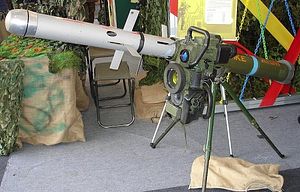The Indian Army is expected to place an order for Israeli-made anti-tank guided missiles (ATGM) as a “stop gap” measure before India’s Defense Research and Development Organization (DRDO) can come up with an indigenous ATGM of its own within the next three years, a source familiar with the matter told Bloomberg News last month.
The procurement proposal is at an advanced stage; however, it has so far not been approved by the Indian government, the source said. A spokesperson from Israeli defense contractor Rafael Advanced Defense Systems Ltd. confirmed that talks are ongoing, although there also have been Indian media reports that the deal has been cancelled for good.
The Indian government scrapped a $500 million deal with Rafael for 321 Spike ATGM systems and 8,356 missiles in favor of an indigenous ATGM system currently under development by DRDO in December 2017. The Indian Ministry of Defense had originally selected the Spike ATGM over the U.S.-made FGM-148 Javelin ATGM system in October 2014.
Nonetheless, Israeli Prime Minister Benjamin Netanyahu, during state visit to India in January 2018, announced that the deal was “back on track.” The Indian government has not commented publicly on the Israeli prime minister’s announcement until now, nor has it confirmed ongoing negotiations over the acquisition of Spike ATGM systems.
The defense ministry can expect strong opposition to any government-to-government deal from the DRDO largely due to indigenization concerns, according to an Indian Army source in January: “There is stiff resistance from the DRDO. If the government places an order for ATGMs from abroad, it can be accused of promoting foreign suppliers at the cost of the DRDO.”
Nevertheless, the recent news does not to come as a surprise to Indian defense analysts. As I reported earlier this year, the Indian Army claims that it lacks 68,000 ATGMs of various types and around 850 launchers and is 60 percent short of its authorized holdings. Furthermore, its existing stockpile largely consists of obsolete second-generation Milan-2T and Konkurs anti-tank missiles.
“The Indian Army is looking for stopgap measures to quickly address this capability gap by inducting new ATGM systems as quickly as possible,” I wrote in January. “The service is reportedly pushing for a fast-track procurement of 2,500 third-generation shoulder-fired ATGMs and 96 launchers through a government-government contract.”
While DRDO has been working on a shoulder-fired third-generation ATGM, has promised to deliver the ATGM for trials by the end of 2018. Following the successful completion of trials, the ATGM would go in for mass production by 2021. However, the Indian Army does not believe that the indigenous weapon system can be delivered on time or meet the service’s requirements.
DRDO has also been working on another the third-generation ATGM, the so-called Nag, fired from the Nag Missile Carrier (NAMICA), an Indian license-produced variant of the Soviet-era BMP-II armored infantry fighting vehicle. Again, the Army has not been impressed with the weapon system’s performance to date.
Additionally, the Indian Army has repeatedly voiced its concern that indigenous ATGM systems will be more expensive in the long-run to operate by the service. (The Spike ATGM is known for its low life cycle cost and simple but reliable operation.) As I wrote in The Diplomat Magazine in January, the ATGM capability gap is likely to persist in the Indian Army at least until 2022.
































